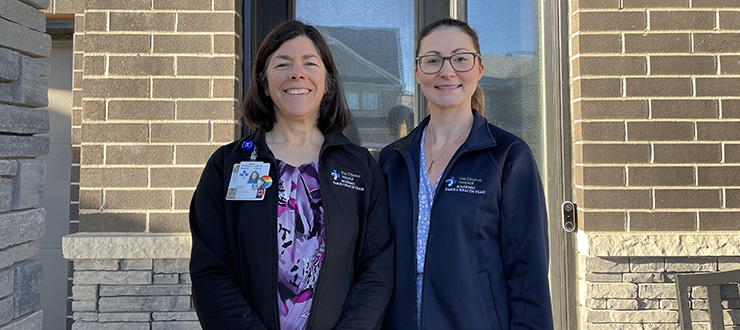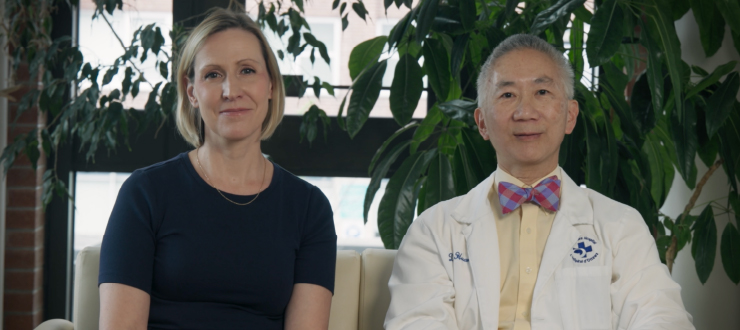
Type 2 diabetes is a serious health condition that affects nearly two million Canadians, but there are actions you can take today to reduce your risk. Registered Nurse Theresa Brideau and Registered Dietitian Josianne Gagnon are both Certified Diabetes Educators with The Ottawa Hospital Academic Family Health Team and lead The Ottawa Hospital’s Ounce of Prevention Program. They offer evidence-based tips on how to reduce your risk for type 2 diabetes.
Sugar doesn’t tell the whole story.
Eating large amounts of sugary foods every day may increase your risk of developing type 2 diabetes, but there are other factors to consider, like family history. Since your brain, pancreas, gut and liver work together as a system to help control blood sugar levels, many of the strategies used to reduce the risk of developing type 2 diabetes also support that system. Yes, it’s complex! That said, what and how much you eat does matter because it affects how well that system works.
There is no such thing as a “diabetes” diet.
Although there is no specific “diet” to reduce your risk of diabetes, there are certain meal patterns that can help manage blood sugars. Having regular mealtimes and spacing them out during the day helps boost your body’s own sugar regulation system.
Following Canada’s Food Guide will help you build a balanced plate and meet your nutritional needs. Make half your plate vegetables and fruits, one-quarter whole grain foods and one-quarter protein foods. This handy portion guide is a useful resource.
Healthy eating doesn’t need to be expensive. Great choices can be fresh, frozen, canned or dried. Check out these tips for healthy eating on a budget.
Carbs are not “bad.”
Many people believe that all carbohydrates are “bad” because your body breaks them down into sugar that ends up in your bloodstream. No foods are bad—but knowing which ones to choose most often can help reduce your risk of developing diabetes.
Instead of cutting out carbs, fill one-quarter of your plate with a low-glycemic index choice like quinoa, barley, bulgur, parboiled rice, sweet potato, steel cut oats, cereal with psyllium, al dente pasta, and breads like heavy mixed grain, spelt, sourdough or whole grain tortilla. These foods are packed with nutrients and provide energy for your brain, but they don’t spike your blood sugar.
That being said, limiting refined carbohydrates like sugars, sugary drinks, desserts, confections, syrups, preserves and bakery products can help reduce your risk.
Think twice about liquid sugars.
Store-bought smoothies and “100 percent pure fruit juice” are often marketed as healthy, but when it comes to reducing your risk for type 2 diabetes, they are better left off the menu. In fact, fruit juice was removed from the latest Canada’s Food Guide.
The human gut absorbs sugars that are in a liquid form (like the sugars in fruit juice) very quickly, which means your body needs to work extra hard to bring it back to a normal level. Plus, when you choose fruit juice, you’re not only getting lots of sugar, but you’re missing out on more nutritious options you could be eating instead.
What’s more, choosing juice can cause you to underestimate how much sugar you’re drinking. If you’ve ever made a glass of freshly-squeezed orange juice, you’ll know it takes about three to four oranges for a small amount—that’s a lot of sugar per gulp! In addition to all of this, when you drink fruit juice, you’re missing out on all of the pulp (and those white parts) that come with eating whole fruit, which is an excellent source of fibre (keep reading…).
Make friends with fibre.
Fibre might be the unsung hero of your digestive system—and a very important part of managing blood sugar and helping you feel fuller longer. Fibre acts as a little cage around a carbohydrate molecule. The cage makes your stomach and gut take a bit more time to break down the carb into a sugar, which keeps your blood sugar levels more steady. Fibre also helps feed your gut, and a well-fed, healthy gut sends helpful signals to the rest of the blood sugar balance system in your body. High-fibre foods include many fruits and vegetables, whole grains, nuts, seeds, beans and lentils.
A little movement goes a long way.
You don’t need to crush it at the gym to reduce your risk of type 2 diabetes. Diabetes Canada recommends getting 150 minutes of moderate physical activity per week, but even a brisk ten-minute walk twice per day can help control blood sugar levels by helping your body get blood sugars into your cells. The goal is to gradually increase your movement, to get your heart beating a little faster, to breathe a little harder and to sweat a little bit. The benefits of exercise stay with you even after your movement ends, so planning some movement at least every second day will help manage your blood sugars over time. Remember to talk to your doctor before starting any exercise program.
These tips are simple, but they’re not necessarily easy. If you’ve been diagnosed with type 2 diabetes, or if you think you are at risk of developing type 2 diabetes, talk to your doctor about how you can start incorporating these tips into your life.
Check your risk with CANRISK.
CANRISK is the Canadian Diabetes Risk Questionnaire to see if you are at risk of developing type 2 diabetes.
The Ounce of Prevention Program at The Ottawa Hospital
Theresa, Josianne and their Riverside Campus colleagues Shannon Merizzi, Registered Dietitian, and Anne Dugas, Registered Nurse, lead the Ounce of Prevention (OOP) Program, a four-week virtual education course. Their interactive, 90-minute classes offer in-depth recommendations on nutrition and physical activity for people who have been diagnosed with prediabetes or are at risk of developing type 2 diabetes. The overarching goal is to help participants go from knowing to doing by teaching them practical strategies to incorporate changes into their lives in a sustainable way.
Do you know someone who might benefit from this program? Potential participants can ask their doctor for a referral, or they can refer themselves through Diabetes Central Ottawa and specify Ounce of Prevention Program in the comments or find a similar diabetes education program in the network. Individual education sessions are also available through Diabetes Central Ottawa.
Resources:
What is diabetes? (Diabetes Canada)

Support patient care and research at
The Ottawa Hospital
You might also like…
Aging well: Guidance for older adults
In this special video series for both older adults and their loved ones, geriatric care specialists from The Ottawa Hospital offer guidance on navigating common health-care challenges that may arise with aging.
How to stay safe around water this summer
Drowning can happen to anyone — even strong swimmers. Emergency physician Dr. Christian Vaillancourt debunks common myths about drowning, explains how to act quickly to save a life, and shares what you can do to keep yourself and your loved ones safe around water.
What’s the difference between an optician, optometrist, orthoptist and ophthalmologist?
“Do I need to see an optician, optometrist, orthoptist or ophthalmologist?” We asked Ophthalmologist Dr. Annick Fournier to break down each role so you will know who to consult for your specific eye care needs.
Understanding rabies: Risks, vaccination and what to do after a bite
Although rare in Canada, rabies is almost always fatal once symptoms appear. Infectious diseases expert Dr. Michaeline McGuinty shares how rabies is spread, when to get vaccinated and what to do after a bite.
“My story doesn’t have to be your story”: New screening test better at preventing cervical cancer
“I went from being a 32-year-old new mom to a cancer patient with an incurable diagnosis.” Alicia’s journey underscores the critical role of HPV testing in preventing cervical cancer. Discover how the new HPV test can save lives and find out how to book your cervical screening appointment with our “Superscreener.”
Sign language interpretation services at The Ottawa Hospital: 5 FAQs
Do you require a sign language interpreter when you come to The Ottawa Hospital? For patients who are Deaf or hard of hearing, we provide both American Sign Language (ASL) and Langue des Signes Québécoise (LSQ) interpretation services at no cost. Before your next appointment with us, find out everything you need to know.


 To reset, hold the Ctrl key, then press 0.
To reset, hold the Ctrl key, then press 0.





